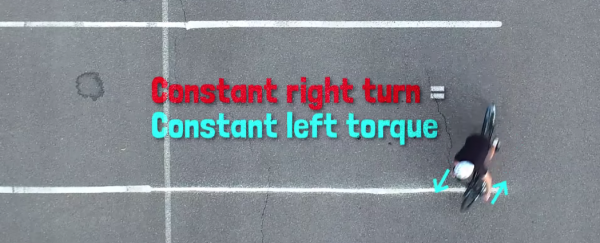In case you haven't heard, bikes are weird. Exhibit A is the so-called 'ghost bike phenomenon', which occurs when a bicycle is travelling so fast, it has the spooky ability to remain upright without a rider. Even when you push it off-track, it somehow manages to right itself. Exhibit B is a lot less spooky but equally weird, and relates to the simple mechanism of just turning a bike left or right. As Henry explains in the latest episode of MinutePhysics, it's a whole lot more complex than you'd think.
Here's how it works. If you're riding a bike and you want to turn right, it makes sense that you would just turn your handle bars to the right. That's how cars work, so why wouldn't it be the same for a bike? Because unlike your sturdy four-wheeled car, your bike is a two-wheeled wobbly disaster, and when you turn the front wheel right, you're gonna cause the whole thing to lean precariously in that direction. In response, you instinctively lean to the left to balance the bike out again, which means you'll end up turning left instead of right, as you'd originally intended.
This is why when we learn to ride a bike, we learn to turn left first when we want to turn right, and turn right first when we want to turn left. We even do it without thinking. But the job's not done once we get the bike on the right course, as Henry explains in the video above, because of that spooky ghost bike phenomenon mentioned above.
Since most bikes and motocycles have a tendency to automatically stabilise and straighten out their wheels on their own, you have to work to keep yourself in a turn. "This happens because a right-leaning bike automatically steers itself even farther to the right to get the wheels underneath its centre of mass," he says.
And guess what? That means if you want to keep turning right - after having turned left first to get you into that right turn - you're going to have to now maintain a constant left torque. So yep, when you want to turn right on a bike, you'll have to turn left, and if you're going to have to keep trying to turn left to maintain that right turn. Counterintuitive? You bet. But the best kind of physics is the mind-bending kind.
Watch the latest episode of MinutePhysics above to see how this all works - trust us, it's a whole lot easier to follow when you're watching an actual bike do it.
